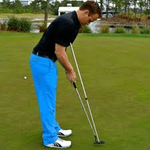Another really good drill requires a simple tool. My pro just had me balance the grip of my driver on the top line of my putter, with the club head resting on my sternum. Then I would take nice smooth swings & make sure the driver didn't fall off. I spent a lot of time doing this drill & it really helped with:
1) keeping my body balanced. I was surprised to find out (via video) how much my body moved around using my old putting stroke. This drill kept me rock-solid from the waist down
2) developing a good feel for what a controlled putting stroke felt like. I eliminated that "hit" urge and my putter just collected the ball at the bottom.
A good drill for becoming a more consistent putter of the ball
Eyeline makes a nice tool for this drill but I can't bring myself to spend the $40.

 eyelinegolf.com
eyelinegolf.com

1) keeping my body balanced. I was surprised to find out (via video) how much my body moved around using my old putting stroke. This drill kept me rock-solid from the waist down
2) developing a good feel for what a controlled putting stroke felt like. I eliminated that "hit" urge and my putter just collected the ball at the bottom.
A good drill for becoming a more consistent putter of the ball
Eyeline makes a nice tool for this drill but I can't bring myself to spend the $40.

Pendulum Putting Rod - Black Edition
The first putt you stroke with the Pendulum Putting Rod may be your best ever. >> Click to View Golfweek's article on PGA Tour Players using the Putting Rod Using the Pendulum Putting Rod helps you with critical fundamentals: A perfect one-piece connection between the shoulders arms, and hands...













